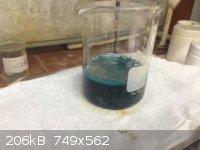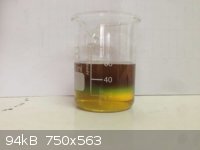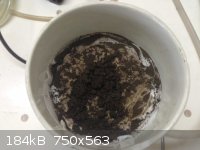
AG525600 - 1-9-2013 at 20:26
Hi,
I'm working on a 'waste' electrolyte solution from a Vanadium Redox battery, which is Vanadium (IV) Sulphate dissolved in 20% Sulphuric acid.
The Vanadium content is ~77,000 ppm, and I'm looking into economical ways to recover the Vanadium into a reuseable product, instead of precipitation
and disposal.
To this end, I've been working with Magnesium chips, another 'waste' stream we handle, to see how far the Mg can reduce the Vanadium - in theory it
should be able to cement out V(0), and neutralise the acid at the same time (with considerable hydrogen generation).
As the reaction took place, there was a clear reduction to a vivid purple (V(II)), then after some time the solution took on a brown coloration. After
some dilution, the addition of some 'fresh' magnesium, and further reaction, there was a black/brown precipitate, and the solution turned colourless.
The second batch worked similarly, though wasn't diluted as much. This batch appeared to cease at the brown-coloured step, with minimal precipitation.
After taking a small sample of the brown liquor, and adding some 12.5% hypochlorite, the attached layering effect was encountered, with the quite
obvious transition of V(V) on the bottom (the hypo sank through the solution), a blue/green layer of V(III) and V(IV), with a faintly detectable
purple V(II) visible underneath the brown layer on top.
Can anyone advise what this brown-coloured liquor may be, or the precipitate? (V(0)? V(I)? V(?)xOy?)
Alternatively, can anyone advise what analytical methods may be employed to determine the oxidation states of the a)liquor and the b) solid?
Cheers,
AG



woelen - 6-9-2013 at 12:07
As long as the liquid remains acidic, you indeed have violet vanadium(II), green vanadium(III) and blue vanadium(IV). I certainly can imagine that you
get these if you add magnesium to a strongly acidic solution, containing vanadium.
If during the reaction with magnesium the acid is used up, then the liquid soon becomes alkaline and then you get the brown hypovanadate-ion in
solution, V4O9(2-). It might be that the brown liquid contains this ion. Try to determine the pH of the brown solution. Is it alkaline or acidic? If
it is acidic, then my suggestion of hypovanadate is wrong and another explanation must be found.
The hypovanadate is formed at really high pH, at slightly alkaline pH, a precipitate of hydrous VO2 is formed, which is dark brown/black.
AG525600 - 10-12-2013 at 21:39
Woelen,
Thanks for the response, your interest in this is much appreciated.
In terms of pH, the end pH of the process is just under 3, and when raw caustic is added, the precipitate is brown leaving a completely colourless
filtrate. I'm trying to get some XRD analysis done to confirm, but I believe the filter cake is V(OH)3.
I have recently also performed a similar reduction process, though electrolytic, which has yielded similar results, albeit with an added jet-black
material having been plated on the cathode (or anode - can't remember which one's which) - presumed to be V2O3.
Given the liquors go to a deep violet colour through the reduction process, there is most definitley V(II) or V(III) present, and I cannot envisage
any V(IV) being present at all.
While I have reasonable confidence of the composition of the solids, the brown colouration of the (reduced) liquor is still confusing. Am also unsure
of how to analyse this to get to an answer - UV-VIS as a start then...?
Any other thoughts welcome
AG
